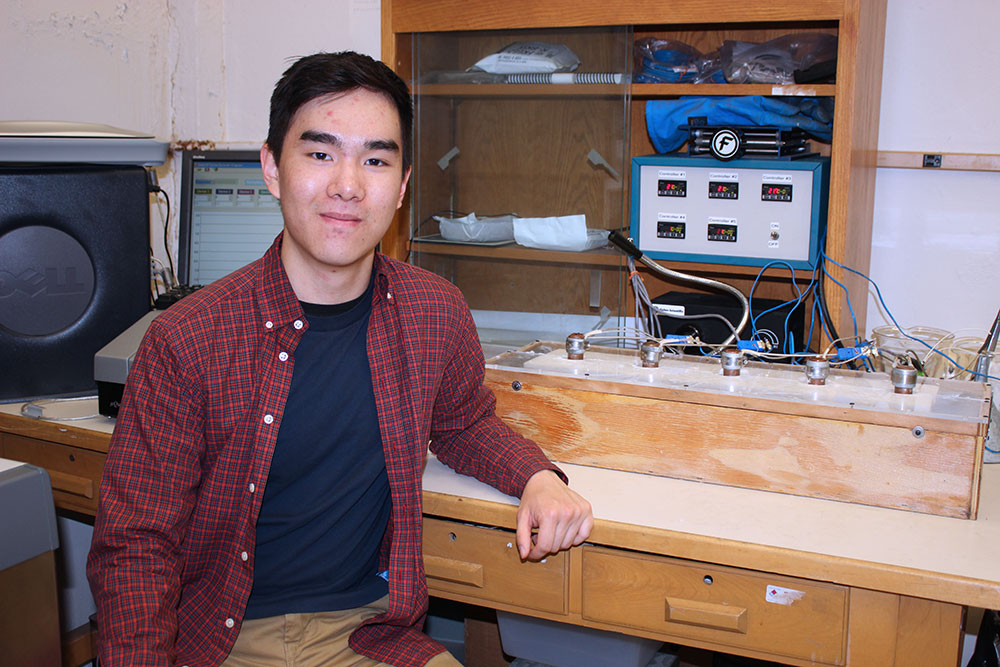MSE Undergraduate is Close to Treating a Very Common Disease
By Amanda Campanaro

Andrew Nguyen, sixth-semester MSE undergraduate, works with a freeze-casting assembly dubbed the ‘Freeze-Castinator 2000,’ which consists of a liquid nitrogen cooling bath and temperature controller used to fabricate our multi-zonal scaffolds.
More than 30 million people suffer from osteoarthritis in the United States, a conservative estimate of the disease that degrades tissue in articular joints. Andrew Nguyen, sixth-semester undergraduate MSE major, is working on creating biodegradable templates (scaffolds) that would be able to induce regeneration of damaged tissue in these joints.
Andrew works in Professor Mei Wei’s lab with Ph.D. student Drew Clearfield and fellow undergraduate Simon Du on the research. Their purpose is to create scaffolds for joint tissue regeneration that will eventually be implemented in a person’s body to mimic the complex structure, composition, and function of native cartilage tissue. His research won 2nd place in the Undergraduate Poster Competition at the 2016 National Materials Science & Technology (MS&T) conference in Salt Lake City, Utah.
“I am motivated to work and research in this field because I know that the research is ground-breaking and will eventually be used to further advancements in medicine and regenerative engineering,” Andrew explains. “Knowing that the research that I do can eventually be used to improve the lives of those who suffer from osteoarthritis is very exciting and makes me want to work even harder.”
Aside from fabricating multi-zonal scaffolds, the group is also planning to conduct cell culture analyses and growth factor studies at the UConn Health Center with their scaffolds. “We are working with the Rowe Laboratory to study the differentiation of chondrocytes and bone marrow stromal cells in our multizonal scaffolds using cells with fluorescent reporter genes,’” Andrew says.

Side-by-side depiction of freeze-casting process of multi-zonal scaffolds with SEM image of its specific zonal architecture. (Image credit: Drew Clearfield)
“Additionally, we have another undergraduate student in our lab who is working on conjugating chondrogenic and osteogenic growth factors to the different compartments in our scaffolds. The goal is to see if we can deliver zone-specific growth factors that enhance the differentiation of seeded progenitor cells.” Since these are essentially biomaterials, it is important that they test the scaffolds using real cells and see how they react within the scaffolds.
“We chose to create anisotropic scaffolds because they mimic the actual structure of functional tissue, which is ideal. Since then, we’ve progressed further along in this field to the point where we have finalized our fabrication protocols and multizonal scaffold designs to fabricate these anisotropic scaffolds easily in high volume,” he explains.
In addition to this research, Andrew is about to be published as a third co-author in Dr. Wei and Drew Clearfield’s paper, Biomimetic Multidirectional Scaffolds for Zonal Cartilage and Osteochondral Tissue Engineering though Freeze Casting Routes in the Acta Biomaterialia for his work on an independent research project conducted last year. “In my independent research project, I conjugated a fluorophore called fluorescein isothiocyanate (FITC) onto a glycosaminoglycan in our scaffolds called hyaluronic acid (HyA),” he says. “Our goal was to track its qualitative distribution throughout the scaffold through confocal scanning laser microscopy.” He’s also been awarded the Academic Innovation Keys Scholarship and Harry and Beatrice Mansley-Peter and Anastasia Hardy Scholarship from the UConn School of Engineering.
Since he began his research in Professor Mei Wei’s lab his third semester at UConn, Andrew has been curious to learn more about the field of Materials Science, not just Biomaterials, and to get hands-on engineering experience where he could apply what he learned in academic coursework to real-life. “There’s just so much to gain from doing research, and I would encourage any MSE student to pursue research during his or her undergraduate career,” he says. Some of the skills Andrew has gained include learning how to conduct independent research projects, utilizing characterization equipment like the SEM, TGA, and DMA, writing technical reports, and giving professional presentations on his work.
Aside from research, there is plenty to be learned from the many materials science and engineering classes offered to undergraduates. “I’d have to say Applied Thermodynamics of Materials taught by Dr. Brody is the most valuable class that I’ve taken thus far in MSE,” Andrew says. “Dr. Brody taught me the underlying principles of how the laws of thermodynamics govern the behavior and properties of materials, but I also learned that in order to be a successful future engineer, both your effort and teamwork with your collaborators are equally important to succeed.”
It was the group effort ultimately that made the class so valuable to Andrew. “Through the many nights of staying up past 2:00 a.m. in ITE to work on our projects, helping each other when we struggled to overcome difficult concepts, seeing how everything we’d been learning in our previous classes ties together and is utilized in more advanced applications, and the feeling of accomplishment when we all finally made it through was so gratifying and has allowed me to become close to many of my peers in the MSE community,” Andrew explains.
At UConn, Andrew is also the Academic Chairholder of Alpha Beta Epsilon, an academic sciences fraternity. “I am in charge of organizing and facilitating academic events for this entire organization such as professor seminars, academic trips to research facilities, professional development workshops, and industry professional panels.” He is also involved with UConn Material Advantage, where he participates in engineering outreach events to elementary schools, industry tours, and volunteer opportunities.
As for his future, Andrew is thinking of working in industry after graduating in May 2018. “I’d like to keep my options open, but am leaning toward industry to be able to utilize the education that I’ve gained here in engineering applications at a company setting,” he says. “I would love to gain more knowledge and experience in other fields of MSE such as metals, failure analysis, and additive manufacturing processes in the aerospace industry.”
Published: March 29, 2017
Categories: news, research, undergraduate students
Available Archives